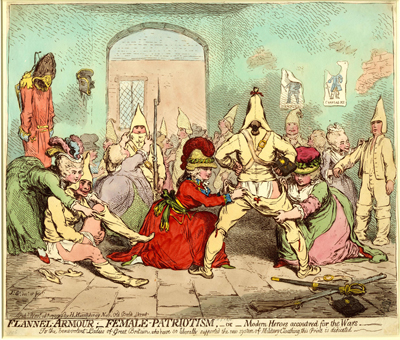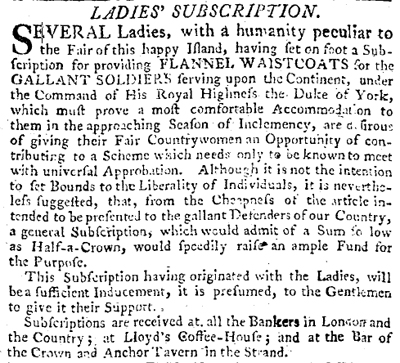Flannel-Armour;_Female-Patriotism. . .
In this delightful print in which he takes full credit for both the drawing and etching, Gillray imagines a hands-on response among the British female population to the growing likelihood that the Flanders campaign, after its initial successes in the Spring and Summer of 1793, would be extended into the colder months of Winter and into 1794. He shows these patriotic women—both old and young, plump and slim—assisting the troops in donning their new "flannel armour" donated as part of the war effort.

© Trustees of the British Museum
Predictably, the print is full of sexual innuendo. The woman on the left bends way over using both hands to pull up a flannel sock over a soldier's one extended member, leaving him to protect a more intimate one (for which his leg may be a symbol) with a scrap of shirt and his hand. Two women with their eyes obviously on the prize pull up the flannel breeches of a soldier with his back to us. It is certainly no accident that the central figure is dressed in vivid scarlet or that a musket with bayonet behind her rises prominently and precisely in the center of the entrance to an interior room.
As early as October 11, 1793, the Edinburgh Advertiser announced the formation of a "VOLUNTARY SUBSCRIPTION for supplying the BRITISH TROOPS on the CONTINENT with FLANNEL WAISTCOATS." The article pointed out that
the present seat of the war [Holland] is a cold and a damp country; and the season is approaching when our soldicrs in those parts may, it is to be feared, be in greater danger from disease than from the sword of the enemy. (P.9)
The announcement was followed by a list of more than 50 Scottish donors, including Lady Dundas, the wife of Sir Lawrence Dundas, Commissary General and supplier of goods to the British Army who must have known a thing or two about cold raw weather and the kind of clothing appropriate to it.
Although the idea for a voluntary subscription for protective clothing seems to have orginated in Scotland, it was soon imitated by dozens of others further south, and enlarged to include "YARN WORSTED STOCKINGS and FLANNEL CAPS," as advertised in the London Times for November 9. In the same article, the "Duchess of Leeds" was listed one of the principal subscribers.
But the most likely inspiration for Gillray's print was the following note appearing in the St. James's Chronicle just nine days before Flannel Armour appeared.

© London St. James's Chronicle
Taking the article at its word, Gillray took the "opportunity of contributing" to the generous scheme, but not in the way that the Chronicle's author intended.
Sources and Reading
- Commentary from the British Museum on Flannel-Armour;_Female-Patriotism. . ..
- Draper Hill, The Satirical Etchings of James Gillray, 1976, #32.
- "Flanders campaign," Wikipedia
- "Siege of Valenciennes (1793)," Wikipedia
- "Sir Lawrence Dundas, 1st Baronet" Wikipedia
- Thomas Wright and R.H. Evans, Historical and Descriptive Account of the Caricatures of James Gillray #104.
- Thomas Wright and Joseph Grego, The Works of James Gillray, the Caricaturist; With the History of His Life and Times, p. 175.
Comments & Corrections
NOTE: Comments and/or corrections are always appreciated. To make that easier, I have included a form below that you can use. I promise never to share any of the info provided without your express permission.